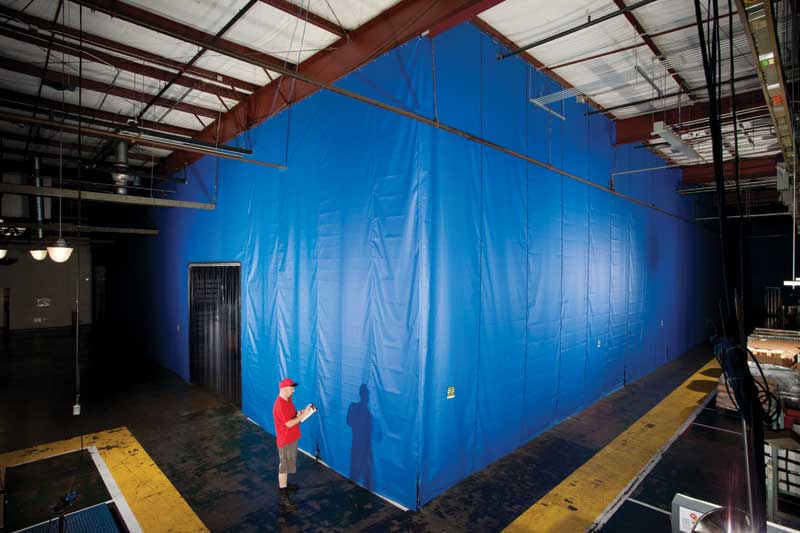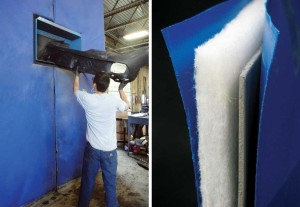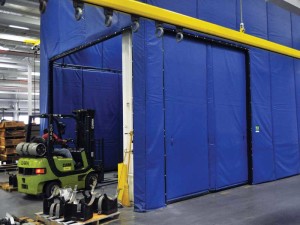Another kind of curtain wall
by Catherine Howlett | March 1, 2013 3:48 pm
 [1]
[1]by Chuck Ashelin
The effects of machine or process noise in a commercial/industrial facility can range from an annoyance to a serious long-term safety issue for employees. The Occupational Safety and Health Administration (OSHA) estimates more than 30 million workers annually are exposed to hazardous sound levels in the United States.
The source of this exposure takes many forms:
- assembly and machine tool operation;
- process equipment (e.g. pumps, compressors, and blowers);
- material-handling equipment (e.g. conveyors and fork trucks); and
- power hand-tools (e.g. saws, grinders, and drills).
Reduction of excessive noise levels is important as an employee safety issue. The effects of human exposure to levels beyond 90 decibels (dB) are cumulative—that is, permanent hearing loss is related to accumulated time exposed to these high levels over a lifetime.
OSHA mandates employers to limit employee noise exposure to 90 dB or less on an eight-hour time-weighted average basis. In typical industrial environments, employers are obligated to monitor workplace sound levels to determine where they stand in relation to this threshold. If found to be above the 90-dB limit, they are required to take action to reduce employee exposure to levels below the limit. On such option would be the use of ‘curtain walls’—an assembly more literal than the glazed building enclosure many associate with this term.
Classic methods of addressing facility noise
Understanding the noise level in question is key to being able to affect the noise transmission. The lower the sound frequency (e.g. bass speakers from another car at a stoplight), the harder it is to mitigate. Mid-range and slightly higher frequencies are easier to manipulate. It is also important to know how the noise is being transmitted—is it being carried by vibration through a concrete floor (e.g. a stamping operation) or through the air from the inner working of machinery (e.g. gears grinding or compressors running)?
There are multiple ways to address noise control issues in an industrial environment, including redesign or replacement of the contributing equipment with new, quieter models. However, this approach may be unfeasible due to the cost or availability of quieter equipment. Noisy machines can sometimes be modified to reduce or eliminate noise-producing vibration—adding isolation pads or vibration dampeners are common approaches. Machines may also be encased in sound-absorbing enclosures or materials.
If these do not offer the desired result, or prove to be impractical to implement, noise-reduction barriers can be placed between offending equipment and the affected employees. This classically consists of rigid, insulated walls or partitions strategically placed to block the path of transmitted sound waves, and absorb and scatter them, reducing the total sound power level that actually reaches the employees.
The final defense against excessive noise involves personal hearing protection on individual employees, such as earplugs or ear muffs (either passive or noise-canceling). While effective protection, they have the shortcoming of only being useful while actually worn, and only when properly fitted. Additionally, in a facility where hearing protection is required, regular hearing testing of affected employees is mandated by OSHA.
 [2]
[2]Flexible acoustic curtain walls
Flexible, acoustic ‘curtain walls’ represent a new approach to sound control. Sound-insulating industrial fabric curtains normally consist of two layers of a woven, coated material surrounding one or more layers of various insulating materials. These might include:
- fiber batting (polymer or glass);
- open-cell blown polyurethane foam sheets;
- densified ‘loaded’ vinyl; or
- another flexible polymer sheet material.
Each one plays its own important role in reducing sound levels impinging on the curtain surface. For example, the mass-loaded vinyl sheet in a sound curtain is more effective in lowering frequency noise than the other components (low-frequency sound is best absorbed or deflected with high-density solid materials). Fiber batting is effective in decreasing sound at mid- to higher-range frequencies. Open-cell foam (e.g. a viscoelastic) also offers noise reduction over a range of frequencies, but care must be taken to ensure the foam used is effectively treated for flame retardant.
 [3]
[3]The interior core of a typical sound curtain consists of a layer of sound-dampening loaded vinyl and a layer of antimicrobial polyester batting as an additional sound buffer, which also serves to fill out and maintain the panel’s body. This core is captured between two outer layers of 560-g (18-oz) flame-retardant vinyl, available in numerous colors for aesthetics. Typically, the core’s loaded vinyl side is positioned between the offending noise source and the desired ambient sound area. In a completed installation, the wall traps the sound in a specific area and limits the migration of the sound to the ambient employee areas.
Flexible acoustic curtain walls offer a relatively new approach to providing employee safety and comfort when it comes to noise levels in a commercial or industrial facility. These fabric curtains can be effectively used for both noise source and noise path insulation. Noisy machines can be blanketed in flexible sound curtains, or the fabric can be attached to a close quarters support frame around the equipment. Larger sound enclosures can be formed using these curtains, including complete rooms or separating walls.
In a typical application of this sort, a metal mounting angle is installed across or along a run of the roof-supporting bar joists (e.g. welded, clamped, or bolted), and the insulated curtain is simply screwed to this angle along its top edge using self-drilling screws. The curtains are normally made of 1.5-m (5-ft) wide panels and have vertical velcro attachment hems to join multiple panels, creating a full-width curtain.
Advantages of using curtain walls for industrial noise control
In addition to their excellent noise-reduction performance (with sound transmission coefficients [STCs] ranging from 15 to more than 30), flexible curtain assemblies employed as noise barriers offer additional advantages over rigid wall solutions.
Fabric systems can be configured to fit virtually any interior space, and do not require near the time mandated to build permanent walls. Curtains are constructed of durable, fire-retardant industrial fabric surrounding multiple layers of recyclable, antimicrobial, polyester batting. Individual fabric panels of virtually any length are interconnected with velcro to form each continuous wall.
Unlike a rigid wall, a curtain wall can be easily reconfigured to adapt to changing production demands and floor layouts. It is easy to add to or enlarge an initial curtain wall installation. If source sound levels increase for any reason, it is simple to add a second layer of flexible sound curtain to an existing one, or even to augment an existing rigid wall (a fairly common application). Additionally, these fabric-covered walls can be easily cleaned with simple detergent and water.
Flexible sound curtains not only insulate against noise transmission, but can simultaneously be effective at providing thermal insulation, preventing condensate or frost buildup, and light-blocking.
Case Study: Michigan ‘grindhouse’
A Michigan auto parts company’s noise management challenges illustrate the effectiveness of using sound curtain assemblies. Both a distributor and remanufacturer of replacement parts, the firm refurbishes existing car and truck components as a high-quality, low-cost alternative to original equipment manufacturer (OEM) replacement parts.
In the recycling process, plastic bumpers are stripped of metal so they can be ground into plastic chips. These are then shipped to another recycling operation. Grinding takes place inside a standalone, 836-m2 (9000-sf) facility called the ‘grindhouse.’ The single-story building was built without interior walls except for a bathroom, office, and break room located on one end of the facility. Essentially, a large, open expanse with 5.5-m (18-ft) ceilings—a place where any noise is amplified—operates virtually around the clock during work weeks, with one employee continually feeding the grinder through each eight-hour shift while employees nearby strip bumpers.
When the grindhouse operation began in the fall of 2010, the noise level was significant—roughly 120 dB. To protect employees, the company had them wear both earplugs and earmuffs. Although the ear protection was considered safe, verbal communication between employees inside the facility became virtually impossible whenever the grinder running.
The company’s initial plan was to build a permanent wall around the grinder. Before starting the project, however, they decided to explore other options in a bid to avoid the high costs and delays associated with constructing permanent walls. After reviewing various possible approaches, the company opted for a flexible, reconfigurable fabric wall system that was installed by its own employees.
First, a sound-dampening wall was placed around the grinder, which sits against a back wall in one corner of the facility. Two of the fabric curtain walls were placed along the length of the grinder from front to back and attached to a concrete wall at the back of the grinder with screws and polyester nailing flaps. At the front end of the grinder, velcro connectors secure the front of the enclosure to the two sides. The front wall also has an opening where bumpers are fed into the machine. Velcro connectors tightly seal the cutout that serves as the grinder opening.
With the fabric walls in place, the grinder is completely enclosed. Subsequent tests showed the sound level inside the grind house dropped from 120 to 96 dB—a more than 20 percent reduction. With grinder noise under control, employees working in the facility only need to wear earplugs and can more easily communicate with each other. Decreased noise also made it easier for employees to concentrate, which boosted productivity. Above all, the fabric curtain wall system created a safer environment for employees.
Conclusion
High noise levels in the workplace are a significant health hazard to employees. Although potentially difficult and expensive, dealing with these levels is necessary. Insulated curtain walls represent a cost-effective and flexible alternative to classic methods used for noise abatement, and bring additional benefits to an industrial environment. From employee safety to employee comfort resulting in higher productivity, the benefits of using insulated curtain walls to keep noise levels under control are real.
Chuck Ashelin is the engineering manager for Zoneworks. A 15-year industry veteran, he holds a bachelor’s degree in chemical engineering. Ashelin can be contacted via e-mail at cashelin@ritehite.com.
- [Image]: http://www.constructionspecifier.com/wp-content/uploads/2013/03/Curtain-Wall-for-The-Construction-Specifier.jpg
- [Image]: http://www.constructionspecifier.com/wp-content/uploads/2013/03/DSC01540e.jpg
- [Image]: http://www.constructionspecifier.com/wp-content/uploads/2013/03/DSC_0189e.jpg
Source URL: https://www.constructionspecifier.com/another-kind-of-curtain-wall/